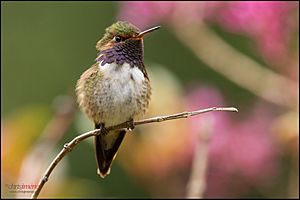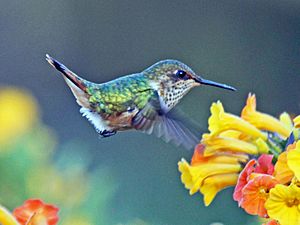Volcano hummingbird facts for kids
Quick facts for kids Volcano hummingbird |
|
|---|---|
 |
|
| Conservation status | |
| Scientific classification | |
| Genus: |
Selasphorus
|
| Species: |
flammula
|
The volcano hummingbird (Selasphorus flammula) is a tiny, colorful bird. It is a type of hummingbird known as a "bee hummingbird." You can find this special bird in the mountains of Costa Rica and Panama. It's so important in Costa Rica that it even appears on their 20 thousand colones money bill!
Contents
Types of Volcano Hummingbirds
Scientists group animals to understand them better. The volcano hummingbird has three main types, called subspecies. These are S. f. flammula, S. f. torridus, and S. f. simoni.
Sometimes, people thought these types were just different color versions of the same bird. Other times, they were even thought to be completely separate species. But for now, they are known as subspecies.
What Do They Look Like?
The volcano hummingbird is quite small. It is about 7.5 to 8 cm (3 inches) long. Males weigh around 2.5 grams, and females are a bit heavier at 2.8 grams. That's about the weight of two paper clips!
Both male and female volcano hummingbirds have a short, straight, black beak. They also have a small white spot right behind their eye.
Male and Female Colors
The male of the main subspecies has shiny bronze-green feathers on its back. Its outer tail feathers are black with reddish-brown edges. The male's throat has a bright, shimmery purple patch called a gorget. The rest of its belly is mostly white. The sides of its chest might have a light brown color with green speckles.
The female also has bronze-green feathers on her back. Her middle tail feathers are green. The other tail feathers have reddish-brown bases, a black stripe near the end, and light tips. Her throat is whitish with dark bronze speckles. The rest of her belly looks like the male's.
Young volcano hummingbirds look a lot like the adult female. They have light brown edges on their back feathers.
Different Subspecies Colors
The S. f. torridus subspecies has more white on its belly than the main type. Males of this subspecies have a purplish-gray throat patch.
The S. f. simoni subspecies has more light brown on its belly. It also has more black on its tail. The male of this type has a bright rose-red throat patch.
Where Do They Live?
Each subspecies of the volcano hummingbird lives in slightly different places.
- The main subspecies, S. f. flammula, lives on the Irazú and Turrialba volcanoes in central Costa Rica.
- The S. f. torridus subspecies lives in the Talamanca mountain range in southern Costa Rica. It also lives on Volcán Barú in western Panama.
- The S. f. simoni subspecies lives on the Poás and Barva volcanoes in central Costa Rica.
These hummingbirds like to live in open or partly open areas on high mountain slopes. You can find them in places like:
- Páramo: a type of grassland with shrubs found in high mountains.
- Areas where landslides or ashfalls have created new growth.
- Bushy pastures.
- The edges of short, dense forests (called elfin forests) and taller forests.
They usually live at heights between 2,000 and 3,500 meters (about 6,500 to 11,500 feet) above sea level. Sometimes, they can be found a bit lower, down to 1,800 meters (5,900 feet). During certain seasons, they might even go as low as 1,350 meters (4,400 feet).
Behavior and Life
Movement
Volcano hummingbirds usually breed in the higher parts of their mountain homes. After they have their young, some of them fly down to lower areas. They might even move to a different nearby mountain. This movement helps the different subspecies mix a little bit.
Feeding Habits
The volcano hummingbird loves to drink nectar from many different kinds of flowers. They mostly visit small flowers found on shrubs, vines, herbs, and small trees. They also drink from bigger flowers that other animals, like bees, have already made holes in.
Male hummingbirds often protect groups of flowers from other birds. Females do this sometimes too, but not as often. Besides nectar, these birds also eat small insects. They catch insects while flying. Females especially like to pick insects off leaves or from spider webs.
Reproduction
The breeding season for the volcano hummingbird is from August or September to February. During this time, male hummingbirds will defend small areas. These areas don't always have a lot of flowers, but flowers are usually close by. Males also perform special "dive displays" to attract females.
The female builds a cup-shaped nest. She uses soft plant material and spider webs. She covers the outside with moss and lichens to help it blend in. The nest is usually placed at the very end of a tree branch, about 1 to 5 meters (3 to 16 feet) above the ground. Sometimes, nests are even attached to roots hanging down from a dirt bank, like near a road. We don't know exactly how long it takes for the eggs to hatch or for the young birds to be ready to fly.
Sounds They Make
When volcano hummingbirds are looking for food, they make soft "chip notes." Male hummingbirds also make a thin, whistling sound like "teeeeeuu." When males fight with other males, they make a chattering, "scolding" call. During their special dive display, the male's tail feathers make a series of quick, loud sounds.
Status and Protection
The IUCN (International Union for Conservation of Nature) has looked at the volcano hummingbird's population. They have decided that it is a species of "Least Concern." This means they are not worried about it becoming endangered anytime soon.
The volcano hummingbird lives in a fairly large area. Its population seems to be stable, with about 20,000 to 50,000 adult birds. All three subspecies live in protected areas, like national parks. Outside of these protected areas, they might even benefit from human activities. This is because they are more common in open areas than in dense forests.
See also
 In Spanish: Colibrí volcán para niños
In Spanish: Colibrí volcán para niños



